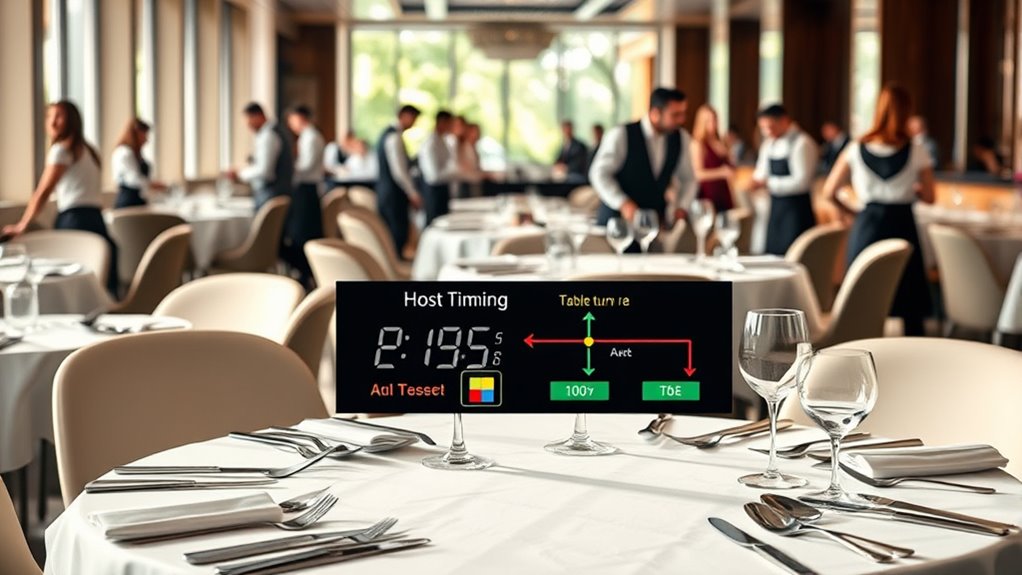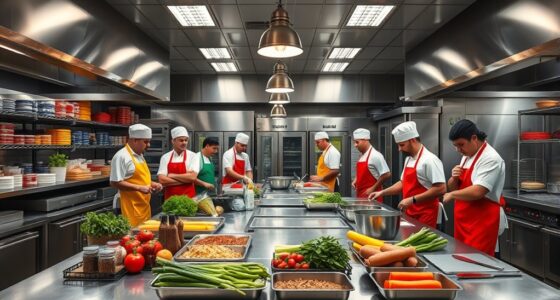Turnover rate measures how often a table is occupied and vacated within a specific period, indicating how quickly a restaurant resets for new guests. Table turn time tracks the duration a table stays occupied during one visit, reflecting each guest’s dining length. While both metrics influence capacity and revenue, balancing them guarantees efficient service and guest satisfaction. If you keep exploring, you’ll discover ways to optimize these metrics effectively.
Key Takeaways
- Turnover rate measures how many times a table is occupied and vacated in a specific period, indicating overall seating efficiency.
- Table turn time tracks the duration a table remains occupied during a single guest visit, reflecting individual dining length.
- Higher turnover rate can increase revenue but must be balanced with quality service to ensure guest satisfaction.
- Shorter table turn time can boost capacity but risks rushing guests if not managed carefully.
- Both metrics are interconnected; optimizing them improves restaurant flow, capacity, and guest experience.

Understanding the difference between turnover rate and table turn time is essential for optimizing restaurant operations. These two metrics directly influence staff efficiency and customer satisfaction, shaping the overall success of your establishment. When you grasp how they differ and what they measure, you can make smarter decisions that improve flow, reduce wait times, and enhance the dining experience.
Turnover rate refers to how many times a specific table is occupied and vacated during a given period, usually a shift or a day. It’s a measure of how quickly your staff can reset and prepare tables for new guests. A high turnover rate indicates that your team is efficiently clearing and resetting tables, which can lead to more seating availability and increased revenue. However, it’s vital to balance a high turnover with attentive service because rushing guests or neglecting their needs can hurt customer satisfaction. When staff work efficiently to turn tables without sacrificing service quality, guests feel valued and are more likely to return.
High turnover rates boost seating and revenue but must be balanced with attentive service to ensure guest satisfaction.
Table turn time, on the other hand, measures the duration a table remains occupied during a single guest’s visit. It tracks how long a group spends dining from start to finish. Shorter table turn times can boost your restaurant’s capacity, allowing you to seat more guests in the same period. But if you focus solely on reducing these times, you risk rushing diners, which can diminish their experience and decrease satisfaction. The key is to optimize table turn time so that it’s efficient without making guests feel hurried. When your staff manages to serve guests promptly and diligently, you create a seamless experience that encourages positive reviews and repeat visits.
Both metrics are interconnected, yet they serve different purposes. Improving staff efficiency means finding the right balance: turning tables quickly enough to maximize seating but without compromising service quality. When your team is well-trained and organized, they can manage this balance effectively, ensuring each guest feels attended to while your tables stay in rotation. This balance directly impacts customer satisfaction because guests appreciate attentive service delivered in a timely manner. They want to enjoy their meal without unnecessary delays or feeling rushed out the door.
Additionally, understanding and managing these metrics often involves monitoring cookie preferences and privacy settings to ensure that staff can access the necessary data to optimize performance without infringing on guest privacy.
Frequently Asked Questions
How Can Restaurants Reduce Their Table Turnover Time Effectively?
To reduce your table turnover time effectively, focus on efficient reservation management and staff training. Schedule reservations with buffer times to prevent delays and guarantee your team is well-trained to serve quickly without sacrificing quality. Encourage staff to clear tables promptly and reset them efficiently. Implementing these strategies helps optimize seating, increases customer flow, and boosts revenue without compromising service standards.
What Impact Does Turnover Rate Have on Restaurant Profitability?
You might think higher turnover boosts profits, but it actually hurts your bottom line. When employee retention drops, you spend more on hiring and training, and staff scheduling becomes chaotic. This inefficiency reduces service quality and customer satisfaction, ultimately lowering profitability. Ironically, investing in your staff’s stability and well-planned schedules can lead to better service, happier customers, and increased revenue, proving that less turnover often equals more profit.
Are There Industry Standards for Ideal Table Turn Times?
Yes, industry benchmarks suggest that the ideal table turn times typically range from 45 to 60 minutes, depending on the restaurant style. You should aim for these standard durations to maximize efficiency and customer satisfaction. However, keep in mind that local market conditions and your restaurant’s concept can influence these benchmarks. Monitoring your actual table turn times helps you adjust operations to meet or exceed these industry standards.
How Do Customer Satisfaction Scores Relate to Turnover Efficiency?
Customer satisfaction scores directly relate to turnover efficiency because positive guest feedback encourages repeat visits and faster table turns. When your staff maintains high service quality, it boosts employee retention, reducing turnover rates. Happy employees are more efficient, which helps you optimize table turn time. Ultimately, focusing on guest satisfaction creates a cycle that improves overall turnover efficiency, leading to happier customers, better reviews, and a more profitable restaurant.
What Tools or Technology Can Help Monitor and Improve Table Turnover?
Your restaurant’s success hinges on perfect timing, so don’t underestimate the power of reservation management tools and table tracking systems. These technologies act like your personal efficiency army, helping you monitor and optimize table turnover seamlessly. With real-time updates and automated alerts, you’ll breeze through busy hours, improve customer satisfaction, and boost profits—all while keeping your operation running smoother than a well-oiled machine.
Conclusion
Understanding the difference between turnover rate and table turn time helps you optimize your restaurant’s efficiency. For example, if you increase your turnover rate by serving quicker, you might see more customers, but if your table turn time is too short, quality could suffer. Striking the right balance guarantees happy customers and higher profits. Keep these metrics in mind, and you’ll create a smoother, more profitable operation that keeps guests coming back.









